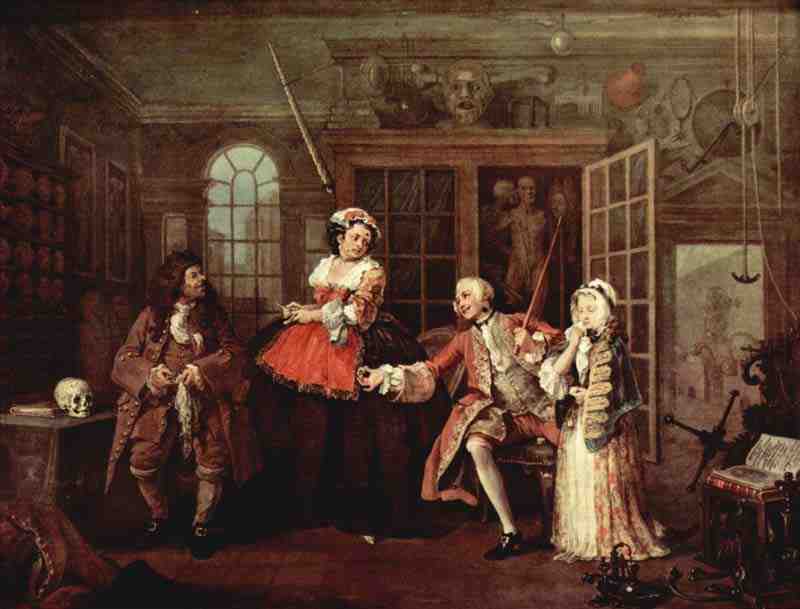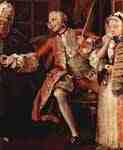
Paintings cycle "Mariage à la Mode," Scene: visit to the quack. William Hogarth
around 1743-1745, oil on canvas, 68.5 x 89 cm
London, National Gallery
---
Gemäldezyklus »Mariage à la Mode«, Szene: Besuch beim Kurpfuscher. William Hogarth
um 1743–1745, Öl auf Leinwand, 68,5 × 89 cm
London, National Gallery
----
----
Fine Art Prints | Greeting Cards | Phone Cases | Lifestyle | Face Masks | Men's , Women' Apparel | Home Decor | jigsaw puzzles | Notebooks | Tapestries | ...
The Inspection is the third canvas in the series of six satirical paintings known as Marriage à-la-mode painted by William Hogarth.
The viscount, suffering from syphilis, makes a visit to a French doctor.
Details
A black patch on the viscount’s neck is Hogarth's device for signifying the Viscount is suffering from syphilis.
The French doctor is based upon Dr. Rock (who can also be seen in A Harlot's Progress). His surgery was at 96, St. Martins Lane, Westminster, London.
The taller woman is opening a clasp knife and is turning away from the viscount who she clearly dislikes. Commentators variously identify her as the child's mother, the doctor's assistant or another prostitute. If she were the child's mother, Hogarth would have almost certainly placed mother and child together.
The cabinet on the left has shelves crammed with apothecary's pots and a wolf's head on the top. On the left wall are two paintings of monsters: one is a man with his head below his shoulders underneath two mummies, and the other of a two headed hermaphrodite.
The cabinet against the rear wall has a door ajar, revealing a skeleton suggestively leaning against an embalmed body. There is also a long wig on a plaster head.
Fixed to the wall and on top of the cabinet, from left to right, there are: a narwal tusk (a classic phallic symbol), a pile of pill boxes, a bleeding basin (identified because of its scalloped side), a glass urinal, a giant plaster head with a huge femur behind, an alchemist's tripod for holding flasks over burners (or a gallows tree), a broken mediaevial comb, a tall red Jacobean hat, two mismatched mediaeval shoes, a spur buckler and a sword and shield.
On the ceiling is a stuffed crocodile with a large ostrich egg hanging from it.
The extremely complicated mechanical contraptions on the right are identified by the inscription on the open book, as being for setting a dislocated shoulder and drawing corks out of wine bottles. An additional inscription on the book reads, "Inspected and approved by the Royal Academy at Paris," Hogarth emphasising the ignorance of the French and their scant knowledge of medicine.
Commentary
Lichtenberg sees the basin, urinal, tripod, hat and spurs as a suggestion that his career has been barber, quack, near execution, doctor and finally knighthood.[1]
See also
Other paintings in the Marriage à-la-mode series
Go back to Marriage à-la-mode: 2. The Tête à Tête
Go on to Marriage à-la-mode: 4. The Toilette
Return to main article
References
Lichtenberg, Georg (January 1798). "1". In Wensinger, Arthur S. and W. B. Coley. Hogarth on High Life (in English, from German) (1 ed.). Middletown, Connecticut: Wesleyan University Press. p. 57. "The Doctor's collection, commenting as it does both historically and prophetically on his career, might be interpreted as follows: he began as a beard trimmer; graduated to piss-analyst; barely skirting the gallows (by virtue of his curative powers) he grabbed for himself a doctor's hat; and is now counting on a knighthood, if he has not one already"
----
Fine Art Prints | Greeting Cards | Phone Cases | Lifestyle | Face Masks | Men's , Women' Apparel | Home Decor | jigsaw puzzles | Notebooks | Tapestries | ...
----
Retrieved from "http://en.wikipedia.org/"
All text is available under the terms of the GNU Free Documentation License



